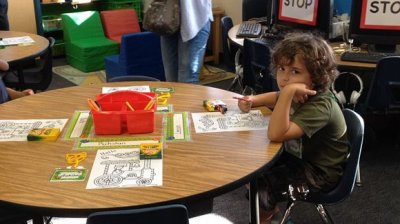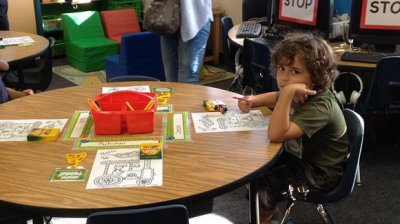人教版英语五年级下册Unit7 a busy day说课稿
人教版英语五年级下册Unit7 a busy day说课稿。说课稿是老师说课过程的一个记录,对大家来说说课稿在学习中有很大的帮助,能够让大家知道老师讲课中的重点知识点,这样大家在学习的时候就能做到有的放矢了,下面大思英语小编为大家带来人教版英语五年级下册Unit7 a busy day说课稿,希望能对大家有帮助。

人教版英语五年级下册Unit7 a busy day说课稿
Good afternoon, everyone. It’s my great pleasure to be here sharing my lesson with you. The content of my lesson is A busy day part A from Unit 7,Fun with English 5B.
一.Teaching contents
The topics on Fun with English are well organized focusing on the pupils’ world. Unit 7 is intended for pupils to talk about their daily lives. They have learnt many verb phrases. Such as watch TV, have breakfast, clean the library, watch a football game, do homework and etc. You know they are bilingual class pupils, so maybe these phrases will be more easier for them. A busy day mainly talks about the time and what they should do at the time.
Considering the contents of the lesson and the levels of the pupils, I design the following teaching aims.
二、Teaching aims
1. Aims on the knowledge: Pupils will learn the new words busy, past, to, on duty, brush teeth, really, half, a quarter , the new structures What time is it? It’s time for… Do you want to…? I want to…
2. Aims on the abilities: To develop pupils’ abilities of listening ,speaking, reading and writing. To develop pupils’ communicative skills
3. Aims on the emotion: To develop pupils’ sense of co-operation. To let pupils know they should cherish the time.
三、Important points:
1. To help the pupils say the new words and use the key sentences correctly.
2. To write whole sentences correctly.
四、Difficult points
1. How to make dialogues and act them out.
2. Pupils can talk about the time and what they should do at the time.
五、Teaching aids
And in this lesson we’ll need CAI , Tape recorder, school things and so on.
六、Teaching methods
Now I’d like to talk about my way of teaching(不必写在教案里).
1. Communication method
I’ll set up a real situation, in this way , pupils can practise in pairs or in groups, they can speak freely and needn’t worry about making mistakes
2. Task-based method
That is to say I’ll let the pupils finish a task by making a short dialogue and acting it out. To help the pupils get a better understanding of the key structures, I will arrange these kinds of activities: singing, guessing game, finishing a survey and having a competition.
七、Learning methods
Let pupils study in a relaxed and agreeable atmosphere. Thereby, develop the pupils’ abilities of studying and working with the learning language independently.
八、Teaching procedures
Now I’ll mainly talk about my Teaching procedures. I’ll follow five steps.
Step 1( Warm-up and revision)
It is important to set up a better English learning situation for the pupils . So I ‘ll design
Activity 1. Sing a song: Do some exercise with me? This song is from Unit6
Activity2. TPR( Total Physical Response ) to ask pupils to follow my instructions, get up, have breakfast, watch TV, do homework then ask and answer: What are you doing? I am…
T: Look, what am I doing?
Present the new phrases: brush my teeth
T: Who is on duty today?
Let the child give the orders which are on the paper.
I design this activity to get pupils to warm up and review the present continuous tense. I also infiltrate two phrases in this step, brush my teeth, on duty. Because they will be presented in the text.
Step 2 (Presentation )
To present and practice the key structures one by one, that’ll be much easier for the pupils to learn and grasp the meanings. So in this step, I’ll design 3 activities.
Activity1: Guess and learn.
Guess a riddle, then learn to express time in English. In this step, I will use CAI to help me with my teaching. Let children practice the time first. Then learn to use past and to
Activity 2: Ask and answer. What time is it? It’s time for…
Let pupils talk about the time : What time is it? It’s time to… Because pupils have already learned this structure .Then teacher can make a model first : It’s time for… Then practice in groups.
As we all know, using the pictures, this is one of the easiest ways to show the meaning of the words and sentences.
Activity 3: Talk and match
Talk about the time and the things first, then listen and match . If time is enough, pupils can talk about their own time and their own things.
Children’s attention span is very short. And proper exercises can help pupils focus on their attention and practice the key structures better.
Activity4: Think and say
T: Oh, what time is it now? It’s time to watch VCD. Do you want to watch VCD?
S: I want to watch VCD.
Teacher shows them a list, look at the time and things: What do you want to do? Then invite your friend: It’s … It’s time for… I want to … Do you want to…?
In this activity, pupils are encouraged to put themselves in the situation and make a face to face talking. All the pupils are involved in this activity. They can talk as much as possible.
Step3. (Production)
To help pupils put the language into using, I design a task to help pupils have a production.
First watch VCD. Let the Ss listen and imitate the dialogue. Pay attention to their pronunciation and intonation. At last I’ll ask the pupils to think hard and act it out. Then find out which group will act it out well. I’ll give them red stars.
Purpose of my designing: This step makes the pupils get the general idea of the dialogue as a whole one. At the same time let the pupils have a chance to practise their listening and spoken ability.
Step 4. (Consolidation)
To develop pupils’ abilities of listening and speaking, that’s the main instructional aims of learning English in primary school. So in step 4, I’ll design some listening exercises to check what they have learned. For example: Think and fill in the blanks. Everyone will have a piece of paper. In this step I’ll give the pupils a free space to show their abilities.
Purpose of my designing: Task-based teaching method is used here to develop the pupils’ ability of communication and co-operation. Tell the pupils we should cherish our time, Time and tide wait for no man.
Step 5. (Homework )
After step 4, some pupils can grasp the knowledge well, but some pupils can’t. Revision is so important, pupils should speak English after class as much as they do in class. It is necessary for the pupils to do some exercise after class. So I design the following homework.
1. Listen and read.
2. Try to talk about the pictures.
3. Try to finish your timetable
My timetable
Time Time What for?
6:30 Half past six It’s time for breakfast.
:
九、.Blackboard Design
Unit7 A busy day
What time is it? busy 繁忙
It’s … past… on duty 值日
It’s … to … brush teeth 刷牙
It’s time for…
Do you want to…?
I want to…?
Proverb: Time and tide wait for no man. 时间不等人。
In a word, the teaching of this lesson aims to develop not only the pupils' language abilities, but also the diverse intelligence. As eachers, to make our English classrooms shine with vitality, we still have a long way to go.
Above is the lecture notes of my lesson. Thank you!
人教版英语五年级下册Unit7 a busy day说课稿。小学教育对孩子们至关重要,家长和老师都要在教育孩子上面多下功夫,这样才能使孩子更加健康的成长,下面大思英语网为大家带来小学生五年级英语怎么辅导,希望能够对小学生学习生活有所帮助。

一、学习英语组织课堂教学,诱发学生的学习兴趣
语言是思维的工具,为了使小学生的思维尽快地与英语联系起来,在英语课堂组织教学中,应尽可能使用英语,做到课堂教学英语话一排除对母语的依赖和母语的干扰,并辅助以手势、动作、表情等,让学生边听边理解老师的意图,在日复一日的反复训练中使学生足渐达到听懂记牢的水平。如教Listen to the tape——recorder时,可反复指着自己的耳朵和录音机示意给学生,通过反复多次的示意后,学生就明白了。又如叫Look at my mouth则指指眼睛,然后再指指自己的嘴,配之以适当的表情,学生就心领神会了。这样,通过日积月累,学生就会听懂很多的课堂用语。为学生创设英语语言环境奠定了基础,从而培养学生直接理解、直接学习、和直接应用英语的习惯。用英语组织课堂教学,可给学生耳目一新的感觉,一下子把学生的注意力吸引了过来。使他们对英语课,产生浓厚的兴趣。
二、运用情景教学法,培养学生的学习兴趣。
小学生的年龄小,接受抽象事物的能力差,他们的感性大于理性,因此,教学中的直观性,特别是对低年级学生,就有其特别的意义。
在课堂教学中,要注意创设情景,多采用看图,听录音等方法,让学生在一定的语言环境中听、说;采用防说、歌曲等,设法在学生面前描绘出一副副图画,让学生边听边理解。这样,将学生置身于情景之中,使学生在自觉和不自觉的状态中去看、去听、去说、去感觉,达到掌握和运用英语的目的。运用情景教学法,使学生积极参与教学活动,在乐中学,培养学生的语言交际能力。
1、创设生活情景
将真实生活情景引进课堂,缩短课堂教学与真实生活距离,给学生提供语言交际的好机会,譬如:在教学A同学在B同学家窜们的一段对话,可先教室的前面布置一番,然后让A同学在外面敲敲们说:My I come in?B打开门说:Oh,it is you,A,come in please!
将A让进屋后说:Set down please!Would you like coffee or tee?A说:Coffee please!B转身给A倒了一杯咖啡,递给他说:Here you are!A有礼貌的点头说:Thank you!由于这种对话的内容、形式都贴近生活,所以学生乐说、爱学,积极性特别高,争先恐后地举手要求对话练习。这样不仅培养了学生在特定场合与人对话的能力,而且不知不觉间养成了礼貌用语的好习惯。
2、在实景中学习英语单词
我们知道,人们对客观世界的认识是从感觉到知觉开始的。感知是认识其他活动的前提,没有感知,就没有认识。而感知过程离不开客观事物本身存在。把英语教学放在实际场景中进行,这不但强化了英语语言的训练,而且发展了儿童的智力。通过学生的语言实践,在字母、单词、句型中发展思维。如在叫vegetables(蔬菜)这课的单词时,事先可以准备些事物,在课堂上,拿这事物逐一给学生说,使学生很快将词义与读音联系起来。又如要学生将见过的动物用简笔画画出来,tiger(老虎)、dog(狗)、pig(猪)、cat(猫)等,通过录音,看口型模仿说。学生们的画创设了实际情景,他们看着自己的画,兴趣盎然!
3、借助动作
小学英语课堂教学,可以视为师生的共同活动,有些行为动词和词组完全可以采用具体的动作使学生理解。如,在教学生dance (跳舞)这个单词时,我先放一段优美的音乐,让一个学生在教师前翩翩起舞,同学们一下子就猜出来他在干什么,这时教dance一词,同学们自然就会把这个读音和跳舞这个动作联系起来。然后拉起同学们的手说:Let dance together!(让我们一起跳舞。)师生共舞,同学们兴趣就会更达到高潮。实践证明,运用情景教学法,能充分调动学生众多感官参与语言学习,能激发学生的学习兴趣。在教学中全体学生一旦被激活,教学能取得很好的效果。
三、运用多种教学方法,巩固学生的学习兴趣。
教学有法,叫无定法。教学方法的优劣,是否引起学生学习兴趣的关系很大。外语教学的实践性很强,因此,就要以灵活多样的方法组织学生进行广泛的语言实践活动。针对小学生喜说爱动、争强好胜、爱模仿、怕羞感少等心理特点,开展各种形式的巩固活动,使学生的大脑皮层始终处于兴奋状态,延长和巩固学生的学习兴趣。有时候甚至可以借助一些英语软件来帮助学生学习英语,推荐能飞视听学习软件,这款软件不仅能加强学生对学习英语的兴趣,还能让学生学好英语,把英语应用到生活上。
1、在玩中学,在游戏中学有所得
游戏是一种能引起学生学习兴趣的好方法,尤其是低年级英语教学的基本活动,灵活运用各种游戏,可以引起学生的极大兴趣。因此,在教学中,教师不但要鼓励学生玩,还要组织学生玩,和学生一起玩,引导学生玩得有意义。
1) 听听做做。在48个音标都叫完后,为了让学生能熟练掌握它们的发音及拼读方法,可将48个音标作成头饰摆在讲桌前,元音着红色,辅音着黑色,然后让学生听音并迅速地戴上相应的音标头饰,请戴辅音头饰的同学做两边的搭桥这,戴元音头饰的同学做过桥者。同学们一起唱London B bridge这首歌,唱到最后桥踏下,一个学生被卡住,其余学生便拼读出这三个音标。通过此游戏,不仅使学生复习了所学的音标知识,同时也培养了他们的拼读能力和快速反应能力。
2)问问猜猜,当学生掌握了一些单词和一些基本句型后,可将几张学过的单词和图片贴在黑板上,让学生们依次说一遍。然后将图片顺序打乱,编上号,遮住图片内容,让学生回答What’s in picture 1(2)…… Is it a …? Yes \ No。这样,学生们的注意力很集中,兴趣很高,都抢着猜图片中的内容。在很轻松,愉快的氛围中,既复习了单词,也巩固了所学的句型。
3)画画拼拼。为让学生巩固所学的四会单词(既会听、说、读、写),可设计这种游戏Drawn a pig,Please。教师边说边在黑板上画一头猪,然后迅速的让学生在玻璃板上仿画,画好后拿到幻灯下显示给大家看。然后,老师说Spell the word ‘pig’,please!学生一个接一个的站起来指着自己的画拼p—i—g \ pig \。每当一位学生展示完毕,学生为他鼓掌。学生们受到鼓励,无拘无束,发言更加勇要,争先恐后。
英语游戏由于带有比赛的性质,参加游戏的人都抱有获胜的心理,这就使参加活动的学生有兴趣学、积极去学,并有助于克服腼腆羞怯的心理障碍。孩子们在游戏中,不仅陶冶了情操,而且激发了表达的欲望,提高了口语实践能力,很大限度地调动了学生的主动性和积极性。
2、在歌中巩固所学的知识
小学生生性活泼,爱唱爱跳。针对这一特点,在教学过程中应着力引导,培养他们的兴趣。如在学完人体器官名称后,我便教他们唱heard and shoulders(脑袋和肩膀),以加深他们对所学单词的认识,优美的曲调再配上相应的动作,同学们都饶有兴趣,歌曲的魅力是无穷的,教完句型I am a boy,you are a girl。将编成歌,再加上手势,学生们很快就学会唱了,而且说得也比以前流利多了。简短、有趣的歌曲,寓学于乐,学生在活泼、轻松、愉快的气愤中自然地获得了英语知识和技能,开阔了视野,发展了智力,提高了教学质量。
为了祖国的花朵的更加全面的发育,我们要做好以上工作,让孩子在课堂上越益的喜欢英语。
上文是大思英语小编精心为大家准备的人教版英语五年级下册Unit7 a busy day说课稿,希望大家能够通过阅读说课稿获得进步,老师们在英语教学时也可以借鉴参考以上方法。





 小学四年级英语小作文
小学四年级英语小作文 小学自我介绍英文范文
小学自我介绍英文范文 五年级下册英语讲课单
五年级下册英语讲课单 小学五年级下册英语作
小学五年级下册英语作 儿童英语练习口语的方
儿童英语练习口语的方 四年级英语口语学习的
四年级英语口语学习的 儿童英语口语练习常用
儿童英语口语练习常用 小学四年级英语上册听
小学四年级英语上册听 四年级英语第一单元知
四年级英语第一单元知 小学四年级上册英语考
小学四年级上册英语考 儿童英语演讲短文演讲
儿童英语演讲短文演讲 小学四年级下册英语题
小学四年级下册英语题 儿童英语水果类单词汇
儿童英语水果类单词汇 孩子对英语不感兴趣怎
孩子对英语不感兴趣怎 四年级英语短文练习填
四年级英语短文练习填 小学英语语法一般将来
小学英语语法一般将来






